Creamy and rich peda is a delightfully sweet fudge-like confection often found in Indian shops and made traditionally with khoya (dried milk solids), sugar, nuts and fragrant spices. But this popular treat is surprisingly easy to make at home! Here you’ll find step-by-step instructions with photos to prepare a simple doodh peda recipe (milk peda) anytime you like.
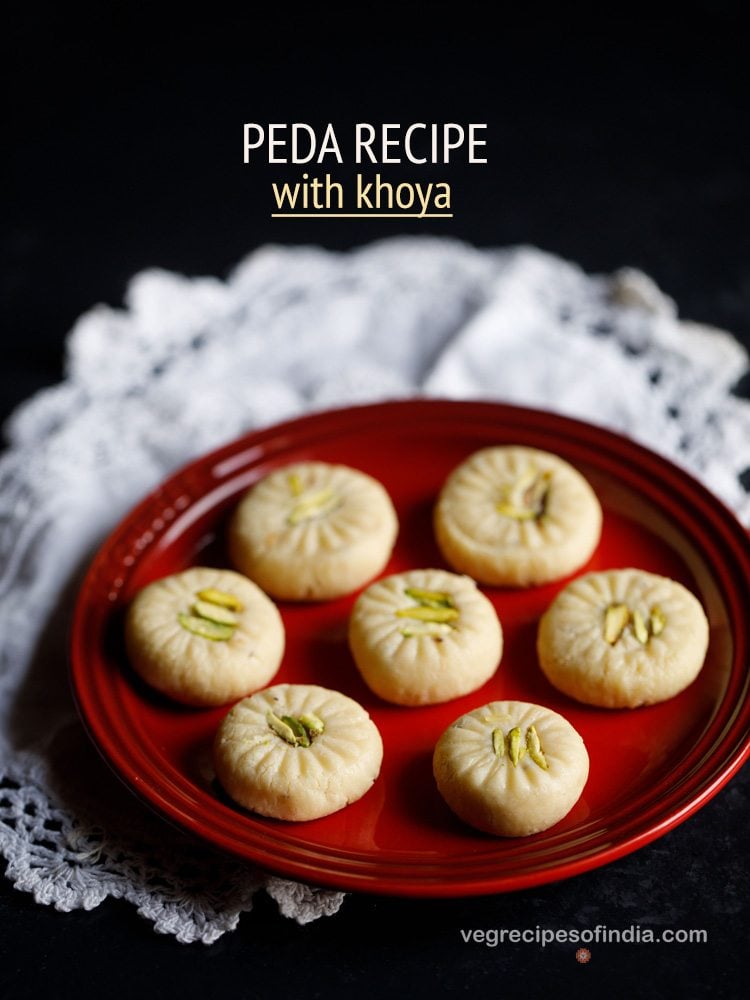
About Peda
Peda is a fairly general term that refers to a wide variety of spherical or round, delicious milk-based fudge treats.
Typically they are made with a combination of dried milk solids (khoya or mawa), sugar and milk, and any preferred flavoring spices.
The mixture is simmered on the stovetop until reduced to a thick consistency, which is then cooled and shaped.
They are also offered to the deities during religious occasions and ceremonies. Sometimes in temples you are also offered peda as a prasad.
Peda can be made two ways. Either you make peda by cooking milk till it thickens, condenses to khoya (which take hours) or use packaged khoya. Some instant peda recipes also use milk powder and condensed milk.
This soft fudgy sweet has many variants. Walk into any Indian sweet shop and you will find many varieties of peda. Few popular varieties have originated in certain Indian regions and are a speciality of that area.
Basically the core ingredients remain the same when you make traditional peda which are – khoya, sugar and flavorings.
Some recipes call for cooking the khoya more until it becomes brown and this does not give a milky taste but a more richer, caramelized taste to the peda.
A few more variations are achieved by adding some dried fruits, chopped nuts, fragrant spices, coconut and make a different version of peda.
Thus there are so many versions of peda! Although I love all the different kinds of wonderful add-ins that you can put in the sweets, I must admit the classic Doodh peda and Dharwad peda are my favorite.
About Milk Peda Recipe
The word “doodh” means milk. Doodh peda refers to the sweet made with milk. Hence also known as milk peda.
While khoya is used to make milk peda, but know that – khoya is nothing but thickened, reduced and condensed milk.
Making khoya from scratch takes a lot of time. If you have time, make your own or opt to make this Instant Khoya that also works like charm to make this doodh peda recipe.
My traditional doodh peda recipe features khoya as the main ingredient. It also includes cardamom, which really compliments the light sweetness of the khoya.
I also top the rolled and shaped peda with sliced pistachios for a great crunch that balances the luscious texture of the milk fudge.
Make a batch of delicious milk peda in only 15 minutes for your next holiday gathering or special occasion or for festivals like Diwali or Holi. They add a tasty and lovely touch to any celebration!
How to Make Peda Recipe
Make Khoya Mixture
1. First grate 200 to 205 grams (about 7.05 oz) of homemade or store bought khoya. You will need 1 cup tightly packed grated khoya.
Add this to a deep pan or kadai. Use a heavy and thick bottomed pan so that the khoya mixture does not brown or burn at the bottom.
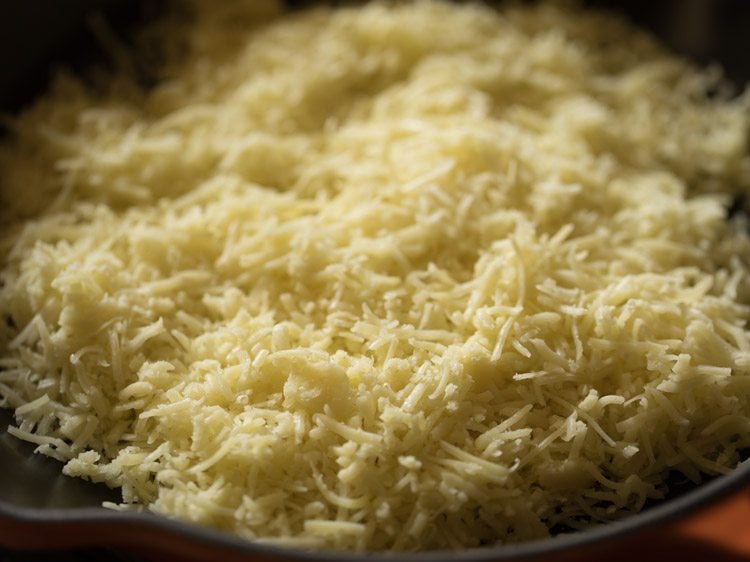
2. Add ½ cup sugar (125 grams) and ½ teaspoon cardamom powder.
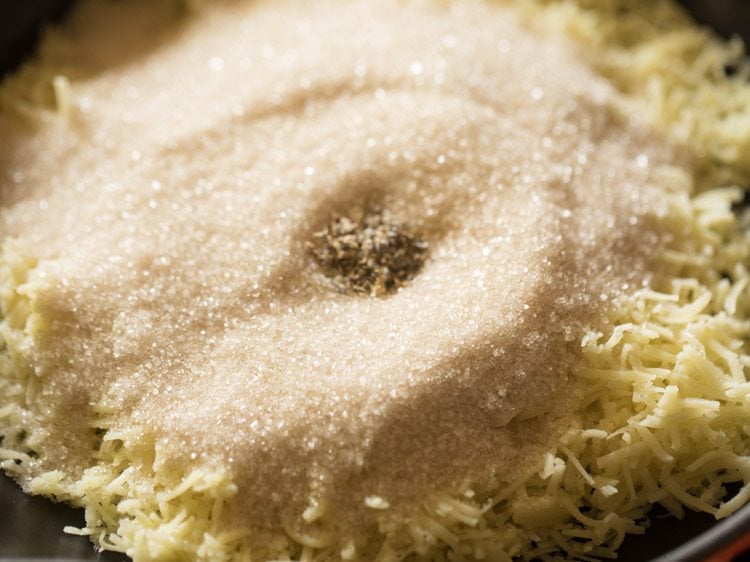
3. Set the heat to low. Then mix in the khoya with the sugar.
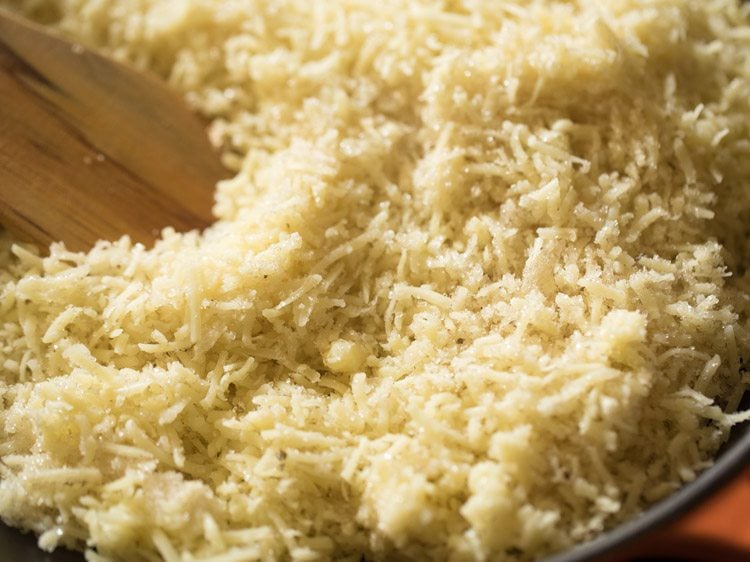
4. Mix evenly and very well.
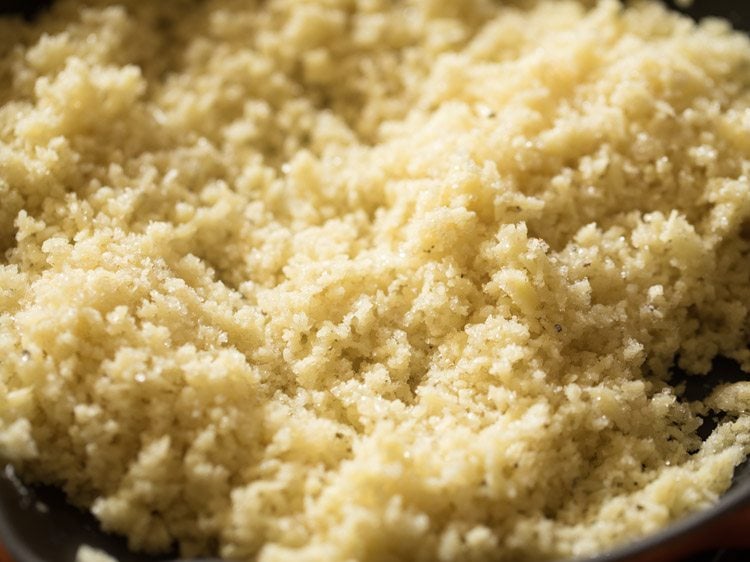
5. Now add 2 to 3 tablespoons milk.
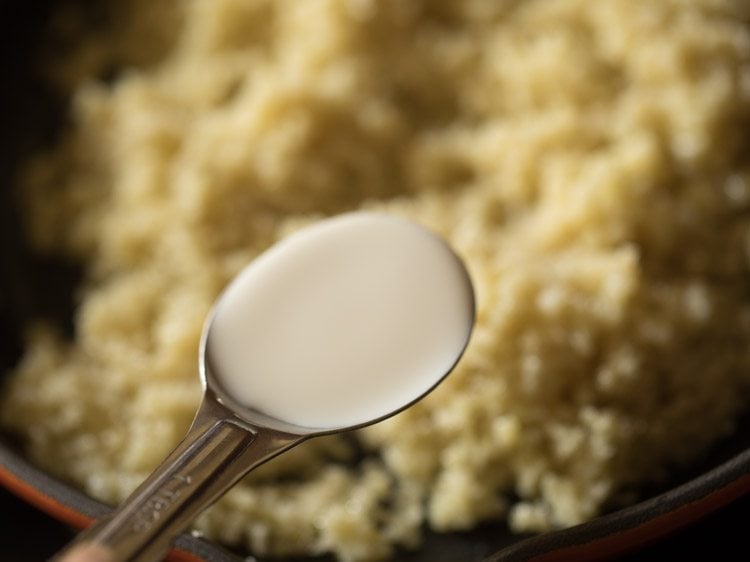
Cook Peda Mixture
6. Mix well. You will see the sugar melting and the mixture becomes more of a liquid.
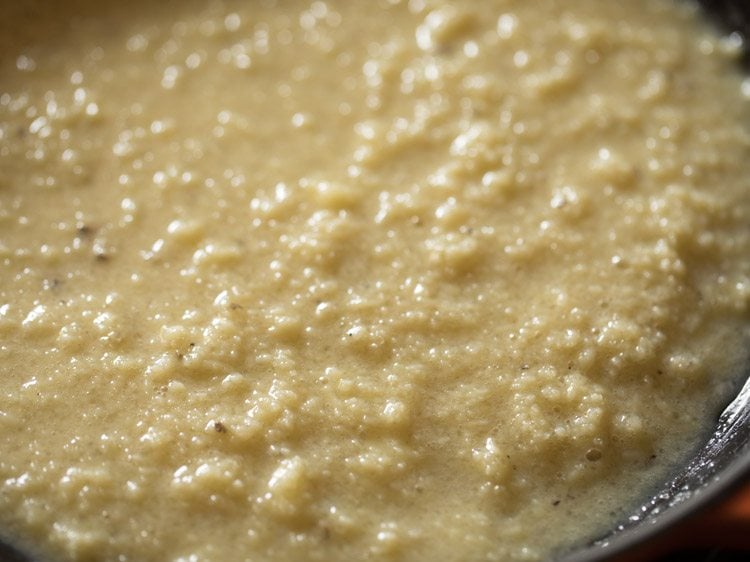
7. Simmer the mixture on low heat while stirring continuously.
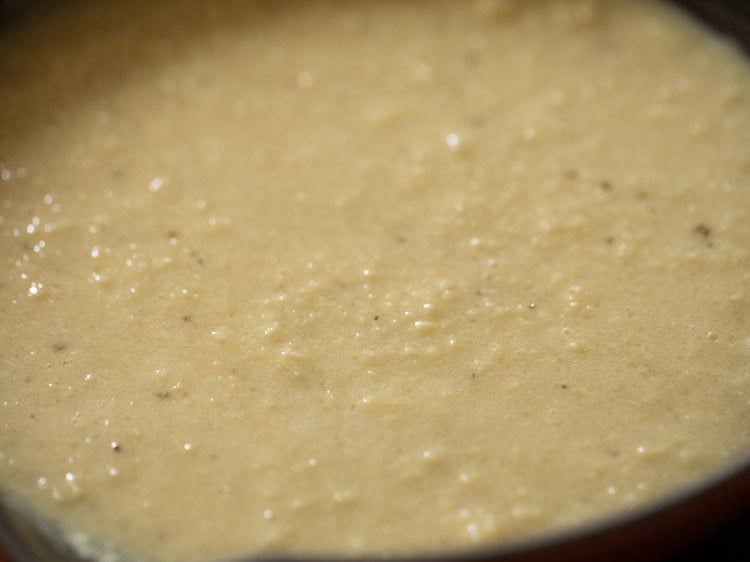
8. You have to stir non-stop so that the mixture does not get browned or stick to the bottom of the pan with a wooden spatula.
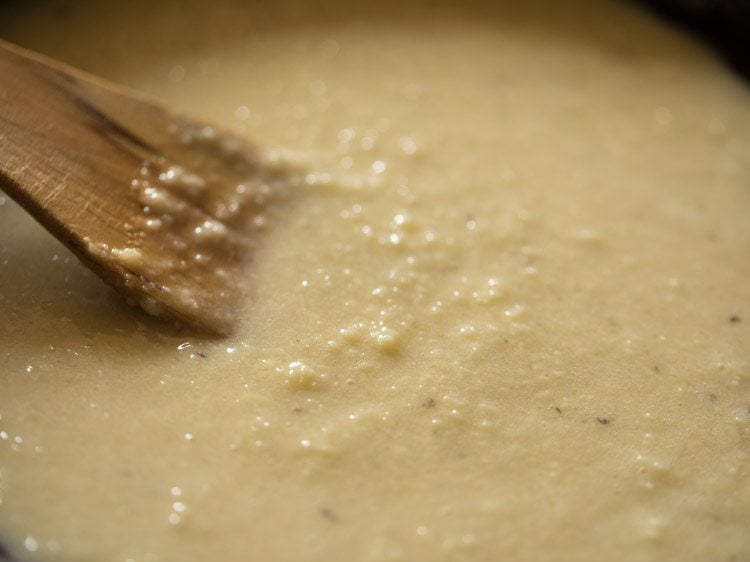
9. Soon the mixture will start to bubble as you stir.
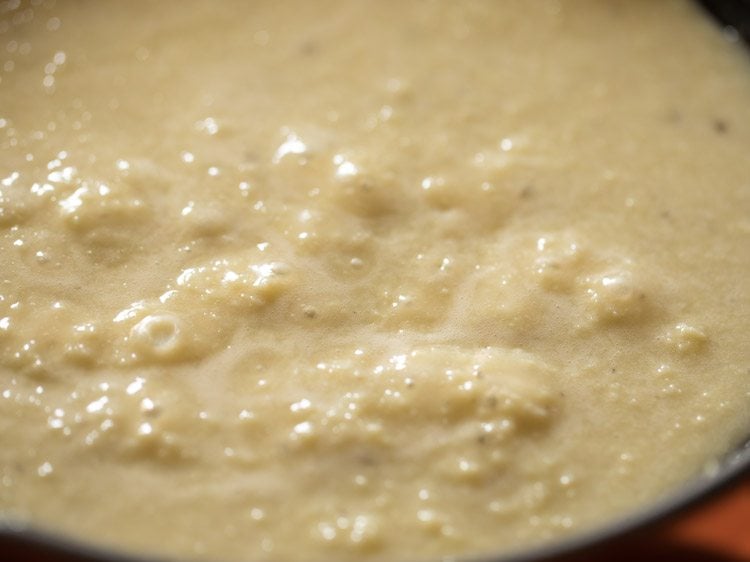
10. Continue to stir and cook until the mixture thickens, and starts to pull away from the side of the pan.
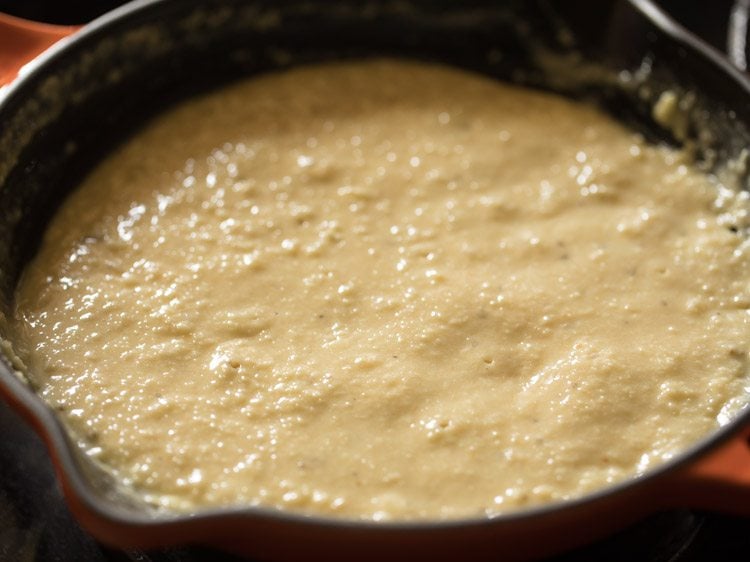
11. In the below photo you can see how the mixture has thickened, condensed and leaves the side of the pan. The color will also change.
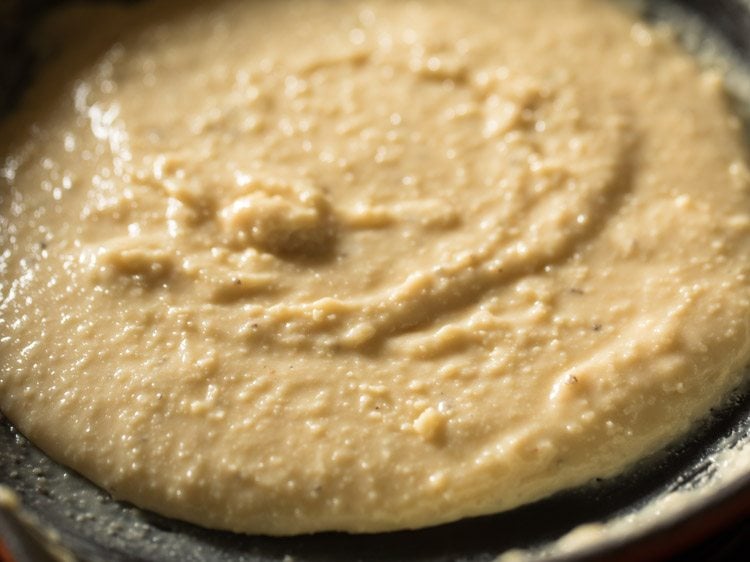
Cool Doodh Peda Mixture
12. Immediately pour the entire molten peda mixture onto a steel plate or tray. It should be thick but still spread a bit. Be sure that you do not overcook the peda before attempting to pour, or the fudge will become chewy.
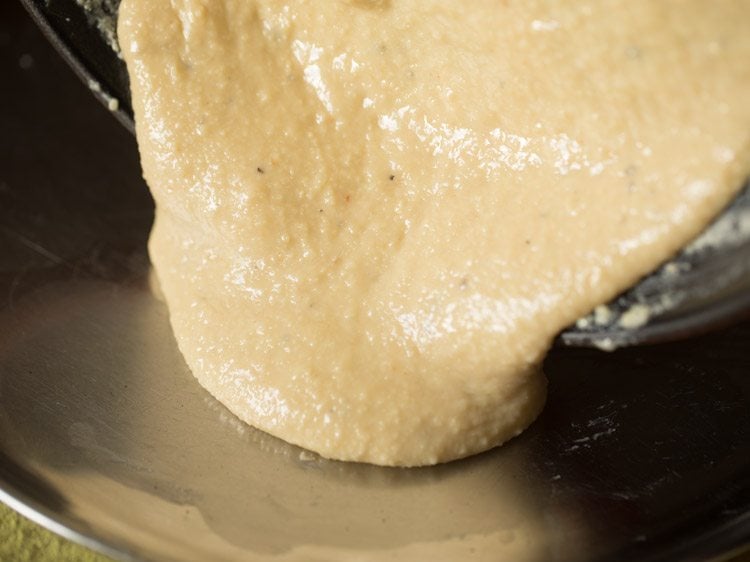
13. Let the mixture cool to room temperature.
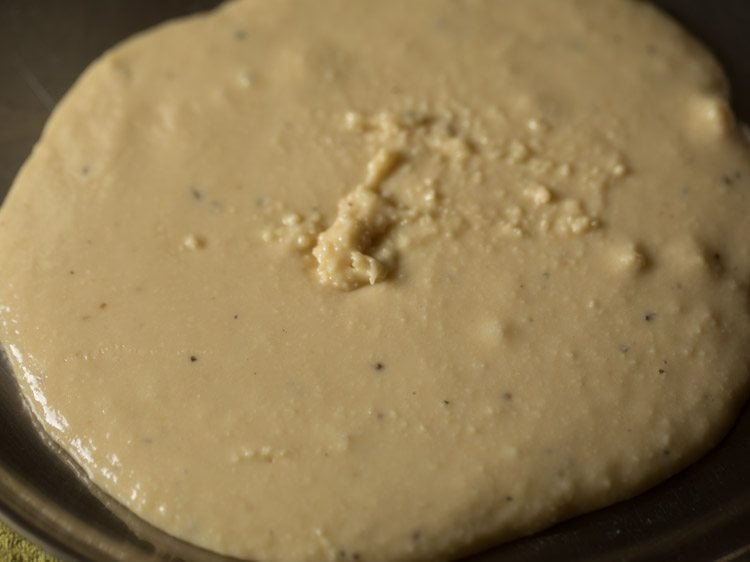
14. In the below photo the mawa peda mixture has become lukewarm.
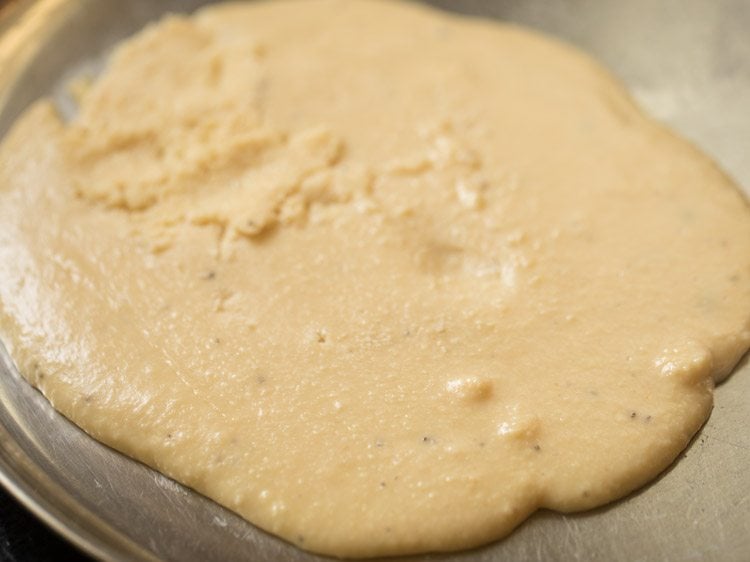
Shape Peda
15. Now take small portions from the lukewarm peda mixture and roll them into small-to-medium balls. They should be about the size of a small to medium lime.
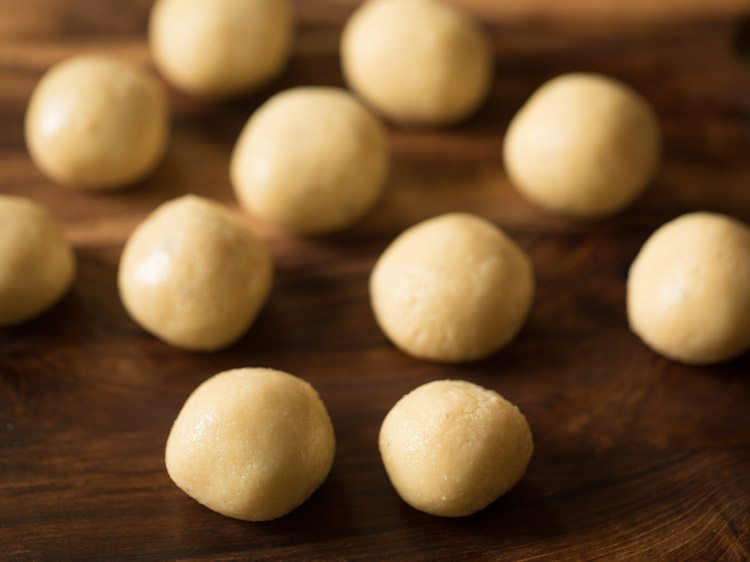
16. Place a few slivered pistachios or almonds on top of each milk peda ball.
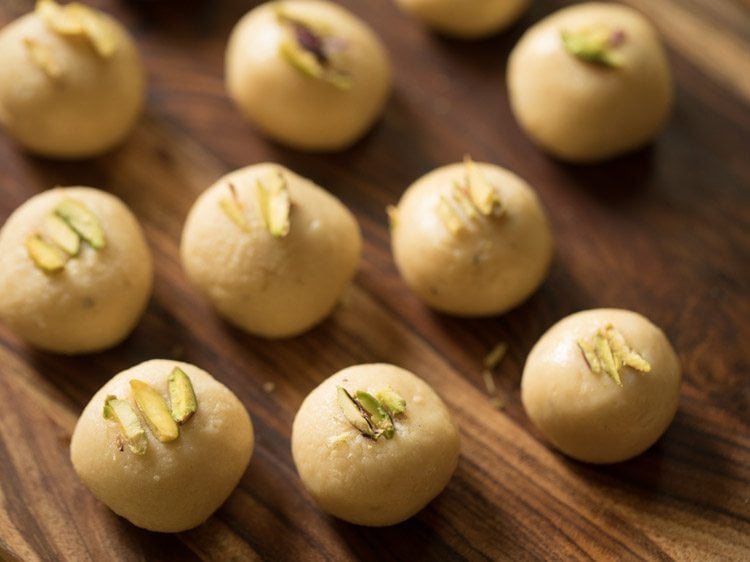
17. With a peda maker or peda press, gently press each ball to flatten and shape the milk fudge. If you don’t have a peda maker you can simply use a flat-bottomed bowl or a small steel glass to press them into a thick disc shape.
You can also roll the mixture in balls between your palms and then flatten them. Press lightly a few almonds or pistachios on top in the center.
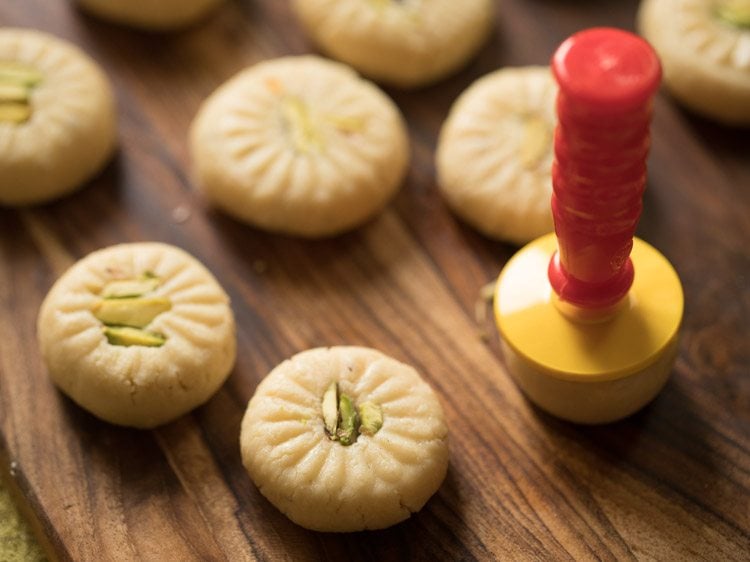
18. You can also top with additional nuts, if you like.
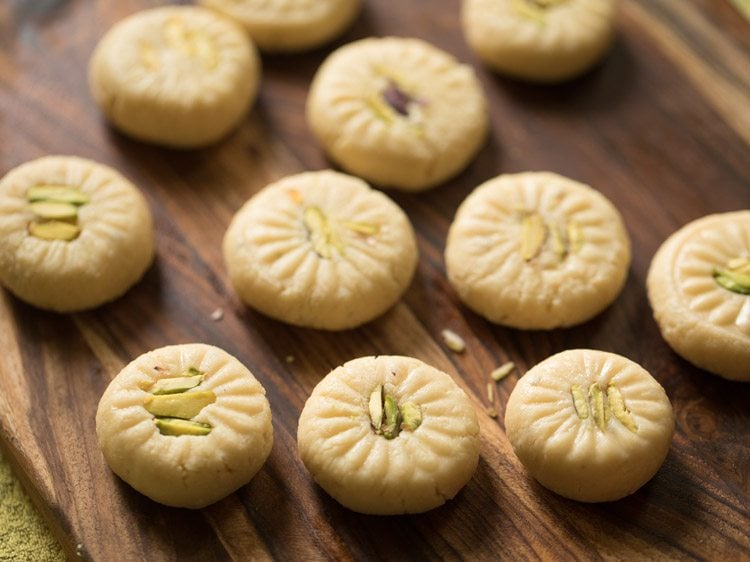
19. Enjoy right away or store the milk peda for a few hours at room temperature and then serve later.
Refrigerate leftovers in the fridge in an air-tight container for about a week. Peda can be eaten at room temperature or cold.
You can also make a large batch and gift them for Diwali or any Indian festival in decorative boxes.
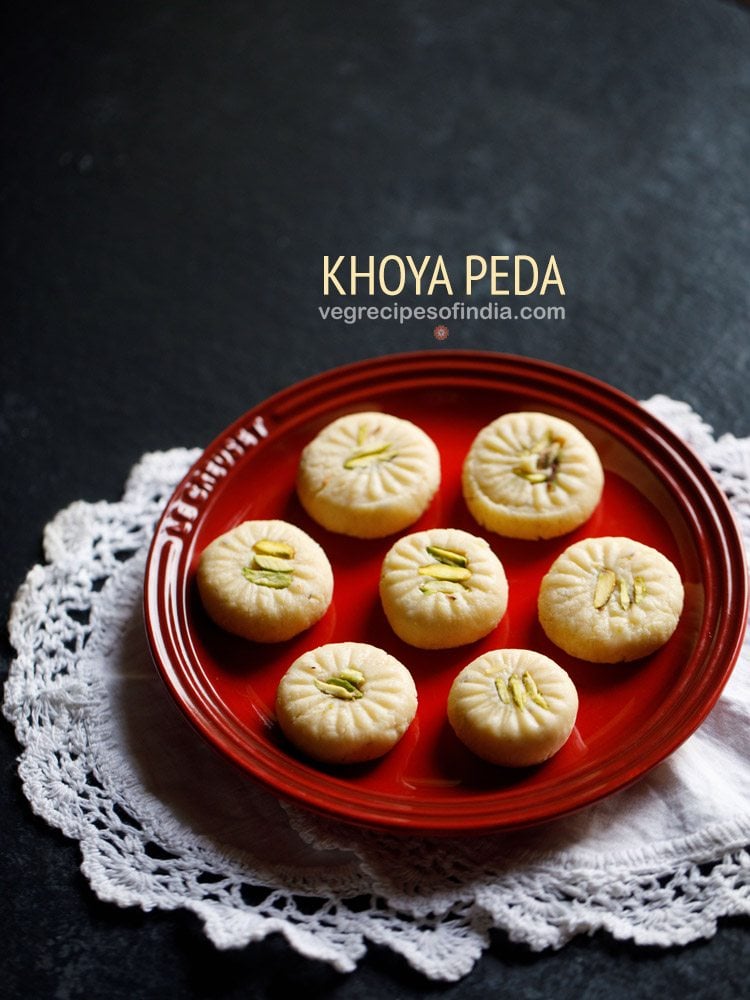
Expert Tips
- Forming peda spheres: I suggest you lightly spread some ghee on your hands while forming the round peda balls.
- Pan type: Use a heavy pan as you do not want the khoya mixture to turn brown or burn. I have here used an enameled cast iron skillet from Le Creuset. As you see in my step-by-step photos, it works nicely. You can also use a heavy steel kadai.
- Nuts: Use your choice of nuts to make this doodh peda recipe. Pistachios and almonds are classic options.
- Flavorings: I love to include traditional cardamom powder in these treats. However, feel free to use saffron, rosewater, or a combination of cardamom and your favorite flavorings.
- Cooking: If your peda fall flat or lose their shape soon after being rolled or stamped or feel sticky, you likely undercooked the mixture. Gather it all back together in the pot and heat again on low, and cook for another 2 to 3 minutes while stirring. Then repeat the pouring, cooling, shaping and stamping process.
Different Types of Peda
- Dharwad Peda: From the city of Dharwad, Karnataka, this peda variant has a darker color. The khoya mixture is cooked to a point where it becomes brown and caramelized. This gives this peda its unique rich taste and nutty flavor. I have had dharwad peda a few times and it is one of my favorite peda variety.
- Mathura Peda: Peda originated in the city of Mathura in Uttar Pradesh. The Mathura peda is the classic variant and very popular.
- Kandi Peda: This peda variety is from Satara, Maharashtra. I have eaten this one and I found it a bit more sweet for my taste. Since the taste for sweetness is relative, my family members enjoyed it and the sweetness was perfect for them.
- Kesar Peda: Here the peda is flavored with exotic saffron giving it a lovely bright orange or yellow color. Saffron is called kesar in Hindi.
- Malai Peda: A richer version, malai peda features malai or clotted cream added to the other ingredients. This peda has a softer and creamier texture because of the cream.
- Chocolate Peda: For chocolate lovers, this is a peda variety that has a rich dark brown color and made with cocoa powder, khoya and sugar.
FAQs
To make this doodh peda recipe, you can use traditionally made mawa or even the instant khoya. I have used instant khoya which I had shared two days back. Making Instant Khoya is quicker and easier than making Mawa in the traditional slow cook method.
Certainly! As-is this doodh peda recipe makes 12 servings. Simply halve the ingredients, or double (or triple!) to make two dozen treats.
Peda can be kept in a sealed container in the refrigerator for up to a week.
More Khoya Based Indian Sweets!
Sweets Recipes
Sweets Recipes
Sweets Recipes
Sweets Recipes
Please be sure to rate the recipe in the recipe card or leave a comment below if you have made it. For more vegetarian inspirations, Sign Up for my emails or follow me on Instagram, Youtube, Facebook, Pinterest or Twitter.
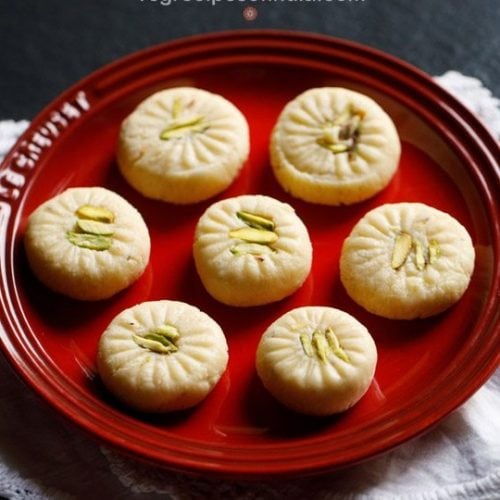
Milk Peda Recipe (Doodh Peda)
Ingredients
- 200 to 205 grams Khoya – grated or 1 cup tightly packed grated khoya (mawa or evaporated and dried milk solids)
- ½ cup sugar – 125 grams sugar or add as required
- ½ teaspoon cardamom powder
- 2 to 3 tablespoons milk
- 3 to 4 pistachios or almonds- slivered or thinly sliced
Instructions
Making peda mixture
- First grate the khoya. Take the grated khoya in a heavy kadai or skillet. You will need 1 cup tightly packed grated khoya. You can use homemade or store brought khoya. I have used instant khoya.
- Add sugar and cardamom powder.
- Keep the pan on a stove top on a low heat.
- Then mix the khoya with the sugar very well.
- Next add milk and again stir to combine. Keep stirring often.
- You will see the sugar melting and the mixture getting a liquid consistency.
- Continuously keep on stirring and simmer the peda mixture with a spatula. You have to stir non-stop so that the mixture does not get browned from the bottom.
- Stir often and the mixture will start bubbling.
- Continue to stir and cook till the mixture thickens and leaves the sides of the pan.
- Then immediately pour the entire peda mixture in a steel plate or a tray. When you pour the mixture it will still be in a molten state but thickened. Do not over cook as then the pedas will become chewy.
- Let it become warm at room temperature.
Making doodh peda
- Now take small portions from the lukewarm peda mixture and roll them into small to medium balls.
- Place a few slivered pistachios or almonds on top of each peda ball.
- With a peda maker, press each ball to give a distinct design on top of it. If you do not have a peda maker, then just roll the mixture in balls and then flatten them. Press a few almonds or pistachios on top.
- Make a design on all doodh peda with the peda maker. In case the doodh peda falls flat and does hold shape, then they are slightly undercooked. Gather all the mixture together and heat again in the pan for 2 to 3 minutes or till the mixture leaves sides of the pan.
- Now you can store the milk peda for a few hours at room temperature and then serve later. Leftovers can be refrigerated. This doodh peda recipe yields 12 medium sized peda.
Notes
- If using packaged or store-brought khoya, check the expiry date. The mawa or khoya should have a mild sweet and milky taste. If it tastes sour or bitter or has gone rancid, then do not use it.
- Remember not to overcook or undercook the peda mixture. Overcooking will make the peda chewy and undercooking will make them sticky. You won’t be able to shape the mixture if it is undercooked.
- Use a heavy and thick bottomed kadai (wok) or skillet. A thin and light-weight pan will brown or burn the mixture while cooking.
- This peda recipe can be halved, doubled or tripled.
- Note that the approximate nutrition info is for 1 peda.
Nutrition Info (Approximate Values)
Peda recipe from the archives was first published on October 2013.
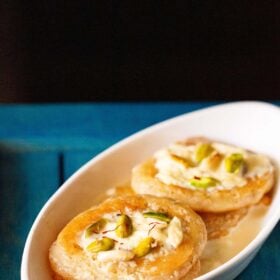
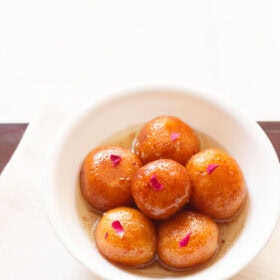
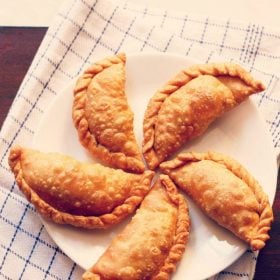
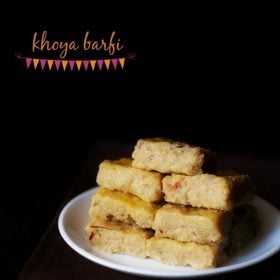
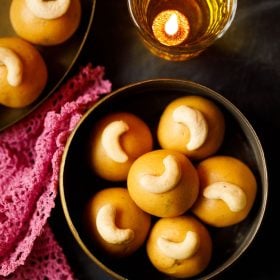
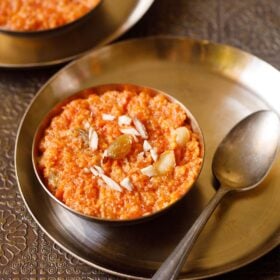
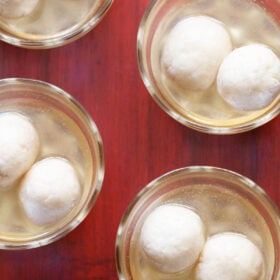
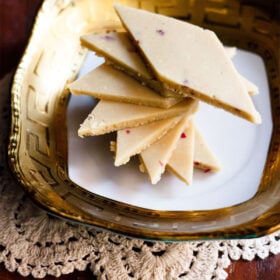








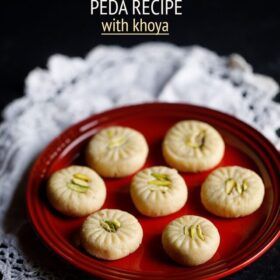
Oh no you have removed the recipe that I always used!!! This link used to give me the microwave peda recipe with condensed milk but now the page has changed! Please please can you upload the microwave recipe!
I will add the microwave peda version in this same post in a few days. I removed it as the post then becomes too long. But I will shorten and add this microwave peda recipe.
Hello Dassana,
Do you know if this will taste good without the cardamom because I am not able to find it where I live.
cardamom gives a very nice aroma. add 1 pinch (15 to 18 strands) saffron (kesar) or rose water if you do have cardamoms. for rose water add 1 tablespoon when the peda mixture is done in the pan. give a mix. for saffron dissolve it in 2 tablespoons of warm milk for 15 minutes. add this mixture to the khoya and then cook everything together.
can we substitute jaggery for sugar.
Mohan, Yes you can.
I made the pedas and they were tasty. Is there option that we can get ready to eat pedas …lol
Thanks for the recepie.
Welcome Sagar. Glad to know that you liked the peda recipe.
Nice one .Thanks For Sharing
welcome.
Thank you..! I made the recipe for Janmashtami..! It was easy and perfect as prasad..!
welcome madhavi, thanks for positive feedback 🙂
Super
thankyou nidhi 🙂
Easier,tastey,quick. Very good
thanks binu.
Hi Dassana
Thank you for the wonderful and easy recipe. I Made this peda for navratri prasad and it turned out really good. My friends loved them and i got tons of compliments. All thanks to you. God bless you.
pleased to know this amisha 🙂 your friends loved the milk pedas. thankyou for trying them and you are welcome.
Yesterday i made ur kadala curry receipe,it was so good nd tasty that everybody liked it….thanks for one more mouth licking dish….gud job
welcome vatsala. nice to know that everyone liked the recipe.
super i liked and also tryed it!!!!
thanks jerin